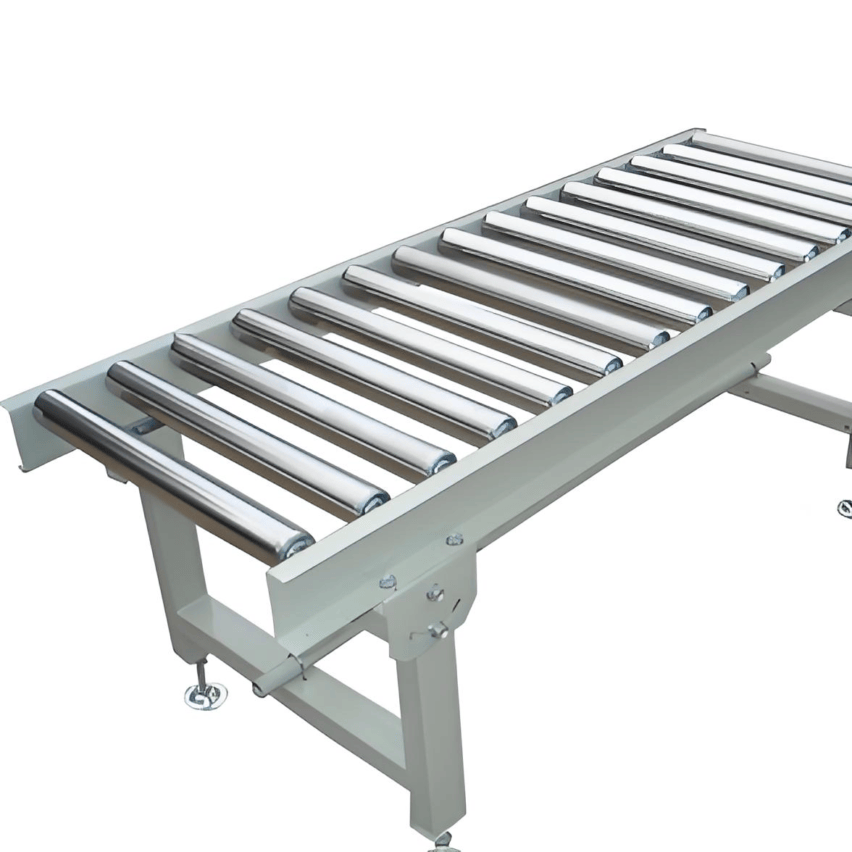I. Core power system: illustration of the four major drive modes
Question: How does a roller line convert electrical energy into transported kinetic energy?
答案关键在于drive system的设计。根据工业场景需求,主要存在四种驱动方式:
- Drum Motor Drive: Integrated motor and drum design, suitable for space-compact scenarios (e.g., food packaging lines), withLow noise, maintenance-freeAdvantage.
- chain drive: connection of several sets of rollers by means of sprockets (common in automotive assembly lines).Load capacity up to 2000kgbut need to be lubricated regularly.
- belt friction drive: Roller driven by friction using rubber belts (suitable for conveying electronic components).Avoid scratches on the material surfaceBut it tends to slip at high speeds.
- bevel gear: Designed for cornering steering, the gears mesh to enable90-degree steering without stickingfor logistics sorting centres.
Comparison table of drive modes:
| typology | Applicable Scenarios | Maximum load | Maintenance requirements |
|---|---|---|---|
| drum motor | Lightweight precision conveying | 300kg | Low (lubrication-free) |
| chain drive | Heavy Industrial Conveying | 2000kg | High (requires regular lubrication) |
| a leather drive belt | Surface sensitive materials | 30kg | Medium (belt replacement) |
| pinion gear | cornering area | 500kg | Medium (gear check) |
Second, the analysis of the whole process of material handling (with the operation of the logic diagram)
Question: How does the material move accurately on the drum line?
The process is divided into five steps that work in tandem:
- mechanical transmission→ 2.friction drive→ 3.linear transport→ 4.Steering/Sorting→ 5.Positioning Uninstallation
Key Stage Details.
- Stage 1: Power Start
The electric motor reduces the speed to 10-30 rpm via a speed reducer (to avoid inertial splashing of the material) and the torque is transmitted to the drive drum via a drive chain/belt. - Stage 3: Friction transport
Static friction is generated between the material and the contact surface of the rotating drum, pushing the material to move at a uniform speed.Adjustable conveying speed (0.5-5m/s)The food industry often uses rubber-coated rollers to increase the coefficient of friction. - Stage 4: Smart Steering
Tapered roller sets (3-5cm difference in diameter) are used in the 90-degree turn area.Outer ring drum speed increase 20%Compensates for path differences and ensures that the material trajectory is not offset.
Industry pain point breakthroughFor easy to dump cylindrical materials (e.g. oil drums), increase the V-type guide groove and photoelectric sensor linkage to dynamically adjust the speed difference of the drum.
III. Intelligent Optimisation and Industry Application Mapping
Question: How can Industry 4.0 upgrade traditional roller lines?
Directions for technology integration:
- Internet of Things (IoT) monitoring: Temperature and vibration sensors monitor the bearing condition in real time.Failure warning response <10 seconds(e.g. anti-stop lines for automotive welding lines).
- Dynamic speed control systems: automatically reduces the speed of the no-load section according to the spacing of the materials detected by infrared.Energy saving rate up to 35%.
- Modular designQuickly change different roller diameters (Φ38mm-89mm) to suit multiple scenarios of box/pallet/bulk crate switching.
Industry Adaptation Programme.
- E-commerce logistics: Accumulation roller line for buffer storage of parcels, sorting efficiency >8,000 pieces/hour
- Lithium battery production: Stainless steel roller + anti-static coating, eliminating metal friction sparks
- Heavy machinery assemblyDouble sprocket drive + hydraulic lifting module to carry 10 tonne engine block
roller conveyor的价值远不止于”物料搬运”——它是柔性生产线的血脉,更是智能工厂的底层逻辑。当锥齿轮在弯道处精准啮合时,物理摩擦的原始力量已悄然进化为数据驱动的工业艺术。未来十年,模块化与AI自适应的结合或将重新定义”输送”的本质:从线性运动到系统思考。













